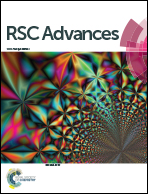Two-dimensional iron–tetracyanoquinodimethane (Fe–TCNQ) monolayer: an efficient electrocatalyst for the oxygen reduction reaction†
Abstract
Searching for efficient, cheap, and stable non-Pt electrocatalysts for the oxygen reduction reaction (ORR) has been a major challenge for the development of fuel cells. Herein, we systematically investigated the potential of the experimentally synthesized two-dimensional (2D) metal–tetracyanoquinodimethane (M–TCNQ, where M denotes Mn, Fe, and Co) monolayers as novel ORR catalysts by means of density functional theory (DFT) computations. Our results revealed that O2 molecules can be chemisorbed and efficiently activated on the M–TCNQ monolayers, and the subsequent oxygen reduction can readily proceed via a 4e− pathway. Among the monolayers, the Fe–TCNQ monolayer exhibits the highest catalytic activity with onset potentials of 0.63 and −0.20 V in acidic and alkaline media, respectively. Remarkably, its electrocatalytic performance could be further enhanced by the attachment of axial halogen ligands. Therefore, the Fe–TCNQ monolayer might serve as a promising alternative to Pt-based catalysts for the ORR in fuel cells.


 Please wait while we load your content...
Please wait while we load your content...